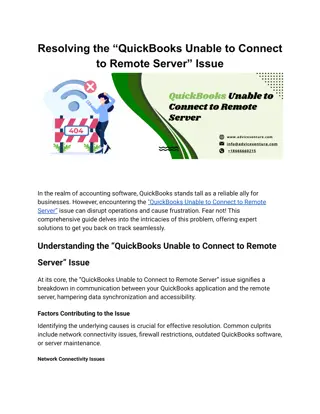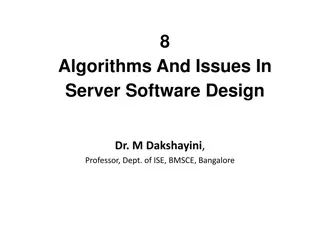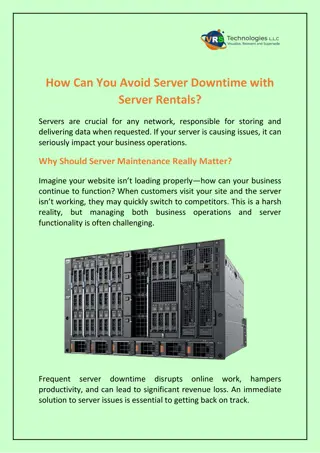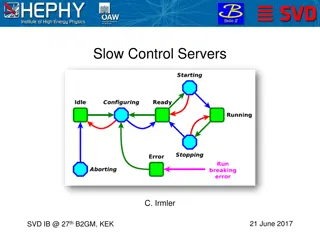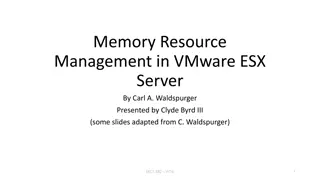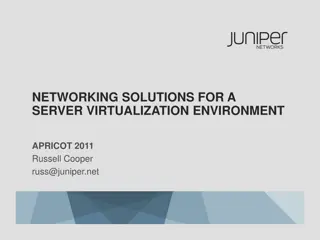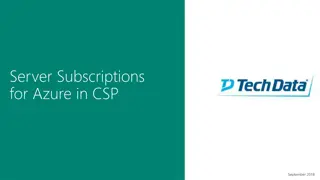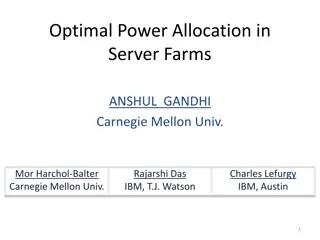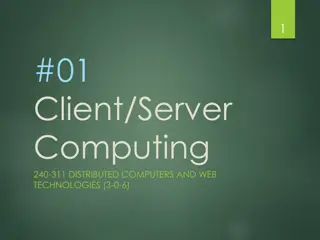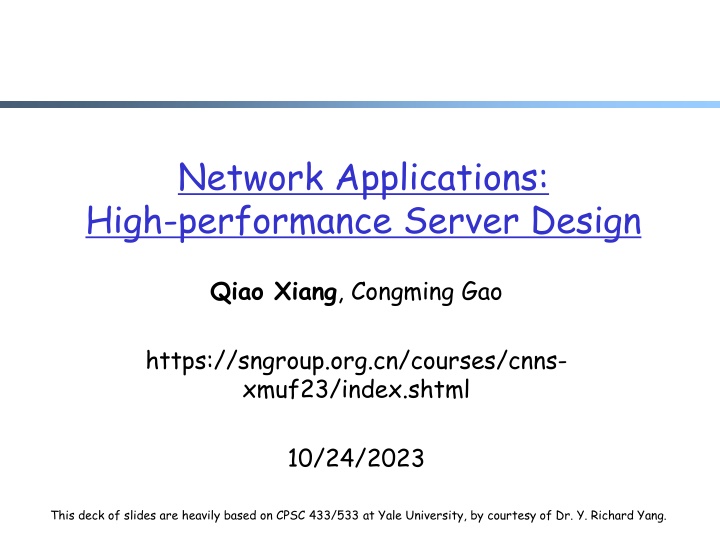
High-performance Server Design for Network Applications
Explore the intricacies of designing high-performance server solutions for network applications, covering topics such as threaded servers, thread pools, latency optimization, and mechanisms for speeding up HTTP/1.0. Learn about load balancing, smart switches, and more to enhance network server performance.
Download Presentation

Please find below an Image/Link to download the presentation.
The content on the website is provided AS IS for your information and personal use only. It may not be sold, licensed, or shared on other websites without obtaining consent from the author. If you encounter any issues during the download, it is possible that the publisher has removed the file from their server.
You are allowed to download the files provided on this website for personal or commercial use, subject to the condition that they are used lawfully. All files are the property of their respective owners.
The content on the website is provided AS IS for your information and personal use only. It may not be sold, licensed, or shared on other websites without obtaining consent from the author.
E N D
Presentation Transcript
Network Applications: High-performance Server Design Qiao Xiang, Congming Gao https://sngroup.org.cn/courses/cnns- xmuf23/index.shtml 10/24/2023 This deck of slides are heavily based on CPSC 433/533 at Yale University, by courtesy of Dr. Y. Richard Yang.
Outline Admin and recap High-performance network server design o Overview o Threaded servers Per-request thread problem: large # of threads and their creations/deletions may let overhead grow out of control Thread pool Design 1: Service threads compete on the welcome socket Design 2: Service threads and the main thread coordinate on the shared queue polling (busy wait) suspension: wait/notify 2
Admin Exam 1 date? 3
Recap: Latency of Basic HTTP/1.0 >= 2 RTTs per object: o TCP handshake --- 1 RTT o client request and server responds --- at least 1 RTT (if object can be contained in one packet) 4
Recap: Substantial Efforts to Speedup HTTP/1.0 Reduce the number of objects fetched [Browser cache] Reduce data volume [Compression of data] Header compression [HTTP/2] Reduce the latency to the server to fetch the content [Proxy cache] Remove the extra RTTs to fetch an object [Persistent HTTP, aka HTTP/1.1] Increase concurrency [Multiple TCP connections] Asynchronous fetch (multiple streams) using a single TCP [HTTP/2] Server push [HTTP/2] 5
Recap: Direction Mechanisms App DNS name1 DNS name2 IP1 IP2 IPn Cluster1 in US East Cluster2 in US West Cluster2 in Europe Load balancer Load balancer proxy servers 6
7 Outline Recap Single, high-performance network server Multiple network servers o Basic issues o Load direction DNS (IP level) Load balancer/smart switch (sub-IP level)
8 Smart Switch: Big Picture smart switch
10 Load Balancer (LB): Basic Structure RIP1 Server1 S=client D=VIP VIP RIP2 Client Server2 LB RIP3 Server3 Problem of the basic structure?
11 S=client D=VIP Problem Client to server packet has VIP as destination address, but real servers use RIPs o if LB just forwards the packet from client to a real server, the real server drops the packet o reply from real server to client has real server IP as source -> client will drop the packet state: listening address: {RealIP.6789, *:*} completed connection queue: C1; C2 sendbuf: recvbuf: state: address: {VIP:6789, 198.69.10.10.1500} sendbuf: recvbuf: state: address: {RealIP:6789, 198.69.10.10.1500} sendbuf: recvbuf: client server
Solution 1: Network Address Translation (NAT) LB does rewriting/ translation Thus, the LB is similar to a typical NAT gateway with an additional scheduling function Load Balancer 12
LB/NAT Flow 14
LB/NAT Flow 15
LB/NAT Advantages and Disadvantages Advantages: o Only one public IP address is needed for the load balancer; real servers can use private IP addresses o Real servers need no change and are not aware of load balancing Problem o The load balancer must be on the critical path and hence may become the bottleneck due to load to rewrite request and response packets Typically, rewriting responses has more load because there are more response packets 16
Goal: LB w/ Direct Reply load balancer Connected by a single switch 17
LB with Direct Reply: Implication VIP Server1 VIP Client Server2 LB Server3 Direct reply Each real server uses VIP as its IP address Address conflict: multiple devices w/ the same IP addr 18
Why IP Address Matters? VIP Each network interface card listens to an assigned MAC address A router is configured with the range of IP addresses connected to each interface (NIC) To send to a device with a given IP, the router needs to translate IP to MAC (device) address The translation is done by the Address Resolution Protocol (ARP) 19
ARP Protocol ARP is plug-and-play : o nodes create their ARP tables without intervention from net administrator A broadcast protocol: o Router broadcasts query frame, containing queried IP address all machines on LAN receive ARP query o Node with queried IP receives ARP frame, replies its MAC address 20
ARP in Action S=client D=VIP Router R VIP - Router broadcasts ARP broadcast query: who has VIP? - ARP reply from LB: I have VIP; my MAC is MACLB - Data packet from R to LB: destination MAC = MACLB 21
LB/DR Problem Router R VIP VIP VIP VIP ARP and race condition: When router R gets a packet with dest. address VIP, it broadcasts an Address Resolution Protocol (ARP) request: who has VIP? One of the real servers may reply before load balancer Solution: configure real servers to not respond to ARP request 22
LB via Direct Routing The virtual IP address is shared by real servers and the load balancer. Each real server has a non-ARPing, loopback alias interface configured with the virtual IP address, and the load balancer has an interface configured with the virtual IP address to accept incoming packets. The workflow of LB/DR is similar to that of LB/NAT: o the load balancer directly routes a packet to the selected server the load balancer simply changes the MAC address of the data frame to that of the server and retransmits it on the LAN (how to know the real server s MAC?) o When the server receives the forwarded packet, the server determines that the packet is for the address on its loopback alias interface, processes the request, and finally returns the result directly to the user 23
LB/DR Advantages and Disadvantages Advantages: o Real servers send response packets to clients directly, avoiding LB as bottleneck Disadvantages: o Servers must have non-arp alias interface o The load balancer and server must have one of their interfaces in the same LAN segment o Considered by some as a hack, not a clean architecture 24
Example Implementation of LB An example open source implementation is Linux virtual server (linux-vs.org) Used by www.linux.com sourceforge.net wikipedia.org More details on ARP problem: http://www.austintek.com/LVS/LVS- HOWTO/HOWTO/LVS-HOWTO.arp_problem.html o Many commercial LB servers from F5, Cisco, More details please read chapter 2 of Load Balancing Servers, Firewalls, and Caches 25
Problem of the Load Balancer Architecture Server1 S=client D=VIP VIP Client Server2 LB Server3 One major problem is that the LB becomes a single point of failure (SPOF). 26
Solutions Redundant load balancers o E.g., two load balancers (a good question to think offline) Fully distributed load balancing o e.g., Microsoft Network Load Balancing (NLB) 27
Microsoft NLB No dedicated load balancer All servers in the cluster receive all packets Key issue: one and only one server processes each packet All servers within the cluster simultaneously run a mapping algorithm to determine which server should handle the packet. Those servers not required to service the packet simply discard it. Mapping (ranking) algorithm: computing the winning server according to host priorities, multicast or unicast mode, port rules, affinity, load percentage distribution, client IP address, client port number, other internal load information http://technet.microsoft.com/en-us/library/cc739506%28WS.10%29.aspx 28
Discussion Compare the design of using Load Balancer vs Microsoft NLB 29
Recap: Direction Mechanisms App DNS name1 DNS name2 IP1 IP2 IPn Cluster1 in US East Cluster2 in US West Cluster2 in Europe - Rewrite - Direct reply - Fault tolerance Load balancer Load balancer proxy servers 30
Outline Admin and recap Single, high-performance network server Multiple servers o Overview o Basic mechanisms o Example: YouTube (offline read) 31
http://video.google.com/videoplay?docid=-6304964351441328559#http://video.google.com/videoplay?docid=-6304964351441328559# You Tube 02/2005: Founded by Chad Hurley, Steve Chen and Jawed Karim, who were all early employees of PayPal. 10/2005: First round of funding ($11.5 M) 03/2006: 30 M video views/day 07/2006: 100 M video views/day 11/2006: acquired by Google 10/2009: Chad Hurley announced in a blog that YouTube serving well over 1 B video views/day (avg = 11,574 video views /sec ) 32
Pre-Google Team Size 2 Sysadmins 2 Scalability software architects 2 feature developers 2 network engineers 1 DBA 0 chefs 33
WebServer Implementation create 128.36.232.5 128.36.230.2 ServerSocket(6789) TCP socket space state: listening address: {*.6789, *.*} completed connection queue: sendbuf: recvbuf: connSocket = accept() read request from connSocket state: established address: {128.36.232.5:6789, 198.69.10.10.1500} sendbuf: recvbuf: read local file state: listening address: {*.25, *.*} completed connection queue: sendbuf: recvbuf: write file to connSocket close connSocket Discussion: what does each step do and how long does it take? 45
Demo Try TCPServer Start two TCPClient o Client 1 starts early but stops o Client 2 starts later but inputs first 46
Server Processing Steps Accept Client Connection Read Request may block waiting on disk I/O may block waiting on network Find File Send Response Header Read File Send Data 47
Writing High Performance Servers: Major Issues Many socket and IO operations can cause a process to block, e.g., o accept: waiting for new connection; o read a socket waiting for data or close; o write a socket waiting for buffer space; o I/O read/write for disk to finish 48
Goal: Limited Only by Resource Bottleneck CPU Before DISK NET CPU DISK After NET 49
Outline Admin and recap Network server design o Overview Multi-thread network servers 50
Multi-Threaded Servers Motivation: o Avoid blocking the whole program (so that we can reach bottleneck throughput) Idea: introduce threads o A thread is a sequence of instructions which may execute in parallel with other threads o When a blocking operation happens, only the flow (thread) performing the operation is blocked 51
Background: Java Thread Model Every Java application has at least one thread o The main thread, started by the JVM to run the application s main() method o Most JVMs use POSIX threads to implement Java threads main() can create other threads o Explicitly, using the Thread class o Implicitly, by calling libraries that create threads as a consequence (RMI, AWT/Swing, Applets, etc.) 52
Creating Java Thread Two ways to implement Java thread 1. Extend the Thread class Overwrite the run() method of the Thread class 2. Create a class C implementing the Runnable interface, and create an object of type C, then use a Thread object to wrap up C A thread starts execution after its start() method is called, which will start executing the thread s (or the Runnable object s) run() method A thread terminates when the run() method returns http://java.sun.com/javase/6/docs/api/java/lang/Thread.html 55
Option 1: Extending Java Thread class PrimeThread extends Thread { long minPrime; PrimeThread(long minPrime) { this.minPrime = minPrime; } public void run() { // compute primes larger than minPrime . . . } } PrimeThread p = new PrimeThread(143); p.start(); 56
Option 1: Extending Java Thread class RequestHandler extends Thread { RequestHandler(Socket connSocket) { // } public void run() { // process request } } Thread t = new RequestHandler(connSocket); t.start(); 57
Option 2: Implement the Runnable Interface class PrimeRun implements Runnable { long minPrime; PrimeRun(long minPrime) { this.minPrime = minPrime; } public void run() { // compute primes larger than minPrime . . . } } PrimeRun p = new PrimeRun(143); new Thread(p).start(); 58
Example: a Multi-threaded TCPServer Turn TCPServer into a multithreaded server by creating a thread for each accepted request 59
Per-Request Thread Server main() { ServerSocket s = new ServerSocket(port); while (true) { Socket conSocket = s.accept(); RequestHandler rh = new RequestHandler(conSocket); Thread t = new Thread (rh); t.start(); } main thread thread starts thread starts class RequestHandler implements Runnable { RequestHandler(Socket connSocket) { } public void run() { // } } thread ends thread ends Try the per-request-thread TCP server: TCPServerMT.java 60
Summary: Implementing Threads class RequestHandler implements Runnable { RequestHandler(Socket connSocket) { } public void run() { // process request } } class RequestHandler extends Thread { RequestHandler(Socket connSocket) { } public void run() { // process request } } RequestHandler rh = new RequestHandler(connSocket); Thread t = new Thread(rh); t.start(); Thread t = new RequestHandler(connSocket); t.start(); 61
Modeling Per-Request Thread Server: Theory k+1 pk+1 0 p0 1 p1 k pk N pN (k+1) Welcome Socket Queue 62
Problem of Per-Request Thread: Reality High thread creation/deletion overhead Too many threads resource overuse throughput meltdown response time explosion o Q: given avg response time and connection arrival rate, how many threads active on avg? 63



